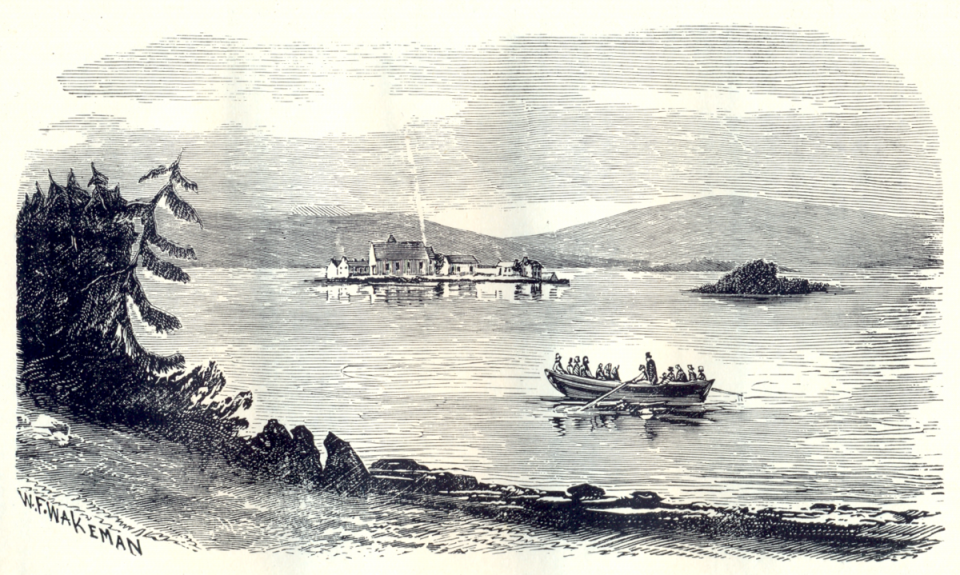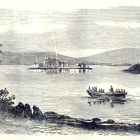In the cultural and religious history of Saint Patrick’s Purgatory—a centuries-old Catholic pilgrim site situated on Station Island within the waters of Donegal’s Lough Derg—the mass drowning of 1795 stands out. The aftermath was devastating, stamping a lasting mark on the memory of place. Some of the drowned were buried without coffins in an improvised mass grave on Friars’ Island to the east of the pilgrim isle, now marked by a copse of fir trees. Others were transported to the ancient parish graveyard. The train of bodies conveyed on horseback was a sight long remembered in Templecarne, a 59.7 mi2 parish encapsulating Lough Derg and the village of Pettigo to its south. Poor families carried other bodies as far as Connacht. Some of the drowned were Catholic pilgrims, others were Protestant boatmen.

Etching by W. F. Wakeman (1822–1900) of Pilgrims in a boat being rowed across Lough Derg with Station Island (left) and Friars’ Island (right) in the background.
Etching by W. F. Wakeman (1822–1900) of Pilgrims in a boat being rowed across Lough Derg with Station Island (left) and Friars’ Island (right) in the background.
Etching by W. F. Wakeman, 1876.
Originally published in O’Connor, St. Patrick’s Purgatory, Lough Derg, plate facing p. 208.
Accessed via Wikimedia on 14 May 2019. Click here to view source.
 This work is licensed under a Creative Commons Public Domain Mark 1.0 License.
This work is licensed under a Creative Commons Public Domain Mark 1.0 License.
The morning begins without disruption. For Catholics, it is time for Sunday Mass. For Protestants it is the day of the “Twelfth,” a holiday commemorating the 1690 victory of William of Orange at the Battle of the Boyne. At this time, the lands and waters of Lough Derg are not under the control of the Catholic Church, remaining the property of the Protestant Leslie family.
Despite Anglo-Irish establishment disapproval and fines, the landholder quietly charges a fee for access to the site. The communities live together, but relations are acrimonious: 1795 also sees the foundation of the Protestant Orange Order—the Pettigo District Lodge is swiftly formed in response to reported attacks on an isolated Protestant community by rural Catholic Ribbonmen.
At the time, the penal laws criminalizing Catholic worship are still in effect, although slowly liberalizing by the 1790s. When he recounts the event in his 1879 pilgrim guide, Canon Daniel O’Connor depicts it as a tragedy exacerbated by negligence and incompetence. O’Connor is part of a growing and assertive community of Catholic authors determined to remediate the reputation of the pilgrimage. His deluxe book is a definitive edition designed to place the pilgrimage in its context, embellished by the engravings of antiquarian and Ordnance Survey artist William Frederick Wakeman. The goal is to document cultural memory as well as valorize the pilgrimage.

Etching by W. F. Wakeman of Templecarne Graveyard, where victims of the 1795 disaster were buried.
Etching by W. F. Wakeman of Templecarne Graveyard, where victims of the 1795 disaster were buried.
Etching by W. F. Wakeman, 1876.
Originally published in O’Connor, St. Patrick’s Purgatory, Lough Derg, plate facing p. 16.
Accessed via Wikimedia on 14 May 2019. Click here to view source.
 This work is licensed under a Creative Commons Public Domain Mark 1.0 License.
This work is licensed under a Creative Commons Public Domain Mark 1.0 License.
Unsafe boating conditions have long plagued the lake’s pilgrim visitors. Its waters were known for what pilgrimage scholar Alice Curtayne describes as “occasionally freakish summer storms” blowing in from the nearby Atlantic coast. On 9 June, during the 1918 pilgrim season, for example, travelers were confronted by a “boiling cauldron of spouting water” accompanied by violent thunder and lightning. The lake has a record of troubling those sailing its waters. Pre-modern accounts describe a journey into Lough Derg as a voyage into death, the boat a coffin entombing the pilgrim. The crossing is highly symbolic, but the boats used to transfer pilgrims are overcrowded.
As O’Connor put it, “the 12th of July, 1795, is a day long to be remembered in connection with Lough Derg.” The eleven o’clock ferry sets out from the boathouse on the southern shore for the Purgatory on Station Island. Mass will be beginning soon. As O’Connor relates, “On that day, which set in fresh and breezy, but by no means very stormy, there was the usual bustle and hurry about the ‘cabin,’ or ferry-house, from an early hour of the morning, amongst pilgrims and the neighboring inhabitants …” Having procured poitín (potato spirits) from a síbín (unlicensed bar) near the ferry house, the boatmen have been celebrating their holiday over the course of the morning. The oarsmen are firmly intoxicated by eleven. The passengers note the boat’s age and bad repair, but their concerns are not heeded.
As the boatload of ca. 93 pilgrims and crew approaches Friars’ Island and Station Island, the vessel encounters difficulties. There is a leak, and the hull is taking on water at an alarming rate. This starts a panic amongst the passengers. Head boatman MacTeague holds his course and endeavors to reach the shore. Commentators speculate that he and his crew, dulled by drink, were slow to realize the danger and react. As the boat approaches the midway point between Friars’ and Station Island, the leak worsens. Pilgrims panic, scrabbling to escape and standing in their seats. In the confusion, the ungainly boat capsizes. The water is less than ten feet deep.
Interactive map of the location between Friar’s and Station Island where the disaster occurred. Click here to view in full screen.
According to O’Connor’s dramatic account, “A few moments after the capsizing of the boat, a large mass of human beings, having grasped each other with the tenacity of death at the bottom of the lake, came to the surface, where they remained struggling for a little, when they sank to rise no more.” The casualties reported vary between seventy and ninety out of ninety-three. Those watching from the island are paralyzed and do not act in time. The accident appears to have had a sobering effect: both Protestant and Catholic history have remembered the event as a tragedy—even Colonel Robert H. Wallace’s history of the Orange Order describes the event as a “melancholy accident.” Both communities lose members.
The disaster continues to be complicated by its entanglement with a contested Catholic and Protestant partisan narrative, and the mode of remembering forges the social identity of religious place. As in tragedies of the post-2013 European Migrant Crisis involving overladen and poorly maintained boats sinking in the waters of the Mediterranean, a web of structure, agency, technology, and environment ensnares the vulnerable.
Acknowledgments
This article was completed during a 2018–20 Irish Research Council Government of Ireland Postdoctoral Fellowship Award.
How to cite
Smith, James L. “The 1795 Disaster: Casualties of the Spiritual Waterscape of Lough Derg, County Donegal.” Environment & Society Portal, Arcadia (Autumn 2019), no. 37. Rachel Carson Center for Environment and Society. doi.org/10.5282/rcc/8763.
ISSN 2199-3408
Environment & Society Portal, Arcadia
 This work is licensed under a Creative Commons Attribution 4.0 International License.
This work is licensed under a Creative Commons Attribution 4.0 International License.
2019 James L. Smith
This refers only to the text and does not include any image rights.
Please click on the images to view their individual rights status.
- Curtayne, Alice. Lough Derg: St. Patrick’s Purgatory. London and Dublin: Burns, Oates & Washbourne, 1944.
- McDaid, Mary, and Pat McHugh. Pilgrims’ Tales and More: Station Island, Lough Derg. Dublin: Columba Press, 2000.
- O’Connor, Daniel. Lough Derg and Its Pilgrimages: With Map and Illustrations. Dublin: J. Dollard, 1879.
- Scriven, Richard. “Geographies of Pilgrimage: Meaningful Movements and Embodied Mobilities.” Geography Compass 8 (2014): 249–61.
- Shalvey, Laura Brigid. “Continuity through Change: A Study of the Pilgrimage to Lough Derg In the Eighteenth and Nineteenth Centuries.” MA diss., NUI Maynooth, 2003.








